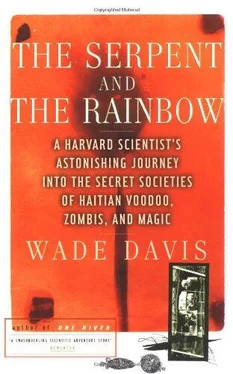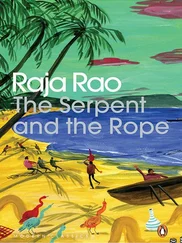Wade Davis - The Serpent and the Rainbow
Здесь есть возможность читать онлайн «Wade Davis - The Serpent and the Rainbow» весь текст электронной книги совершенно бесплатно (целиком полную версию без сокращений). В некоторых случаях можно слушать аудио, скачать через торрент в формате fb2 и присутствует краткое содержание. Год выпуска: 1985, Издательство: Simon & Schuster, Жанр: Старинная литература, на английском языке. Описание произведения, (предисловие) а так же отзывы посетителей доступны на портале библиотеки ЛибКат.
- Название:The Serpent and the Rainbow
- Автор:
- Издательство:Simon & Schuster
- Жанр:
- Год:1985
- ISBN:нет данных
- Рейтинг книги:5 / 5. Голосов: 1
-
Избранное:Добавить в избранное
- Отзывы:
-
Ваша оценка:
- 100
- 1
- 2
- 3
- 4
- 5
The Serpent and the Rainbow: краткое содержание, описание и аннотация
Предлагаем к чтению аннотацию, описание, краткое содержание или предисловие (зависит от того, что написал сам автор книги «The Serpent and the Rainbow»). Если вы не нашли необходимую информацию о книге — напишите в комментариях, мы постараемся отыскать её.
The Serpent and the Rainbow — читать онлайн бесплатно полную книгу (весь текст) целиком
Ниже представлен текст книги, разбитый по страницам. Система сохранения места последней прочитанной страницы, позволяет с удобством читать онлайн бесплатно книгу «The Serpent and the Rainbow», без необходимости каждый раз заново искать на чём Вы остановились. Поставьте закладку, и сможете в любой момент перейти на страницу, на которой закончили чтение.
Интервал:
Закладка:
Marcel took his place in the shade, removing his paraphernalia from his briefcase. He placed a thunderstone—a pierre tonnerre—in an enamel dish and covered it with a magical potion. Thunderstones are sacred to the vodounist, forged as they are by Sobo and Shango, the spirits of thunder and lightning. The spirit hurls a lightning bolt to the earth, striking a rock outcropping and casting the stone to the valley floor. There it must lie for a year and a day before the houngan may touch it. Despite the divine origins, thunderstones are not uncommon in Haiti; Westerners think of them as pre-Columbian axe heads and attribute their origins to the Arawakan Indians.
Marcel struck a match to the dish, and the potion exploded in flames. Dipping his right hand into it, he set his own skin on fire with the alcohol, then passed the flame to each of us, slapping the joints of our arms and rubbing our flesh vigorously. He then tied satin scarves around our faces to ensure that we did not inhale the dust of the poison. As a final protective measure, he coated all exposed skin with an aromatic oily emulsion.
Earlier in the morning I had watched Jean ease his thick fingers into the coffin, inch his way along the corpse of the child, and close his hand like a vise on the skull. It had collapsed, releasing a chemical scent, foul and repulsive. With great trepidation he had lifted the shattered remains out of the impromptu grave and carefully placed them in a jar. Now, with equal concern, his hand dripping with oil, he took them from the jar and placed them on the ground beside the grill. From his sack he methodically removed the other ingredients. The first two I didn’t know—two freshly killed lizards, iridescent and blue. Then he removed the carcass of a large toad that I had seen among other ingredients pinned to the clothesline; dried and flattened it was hardly identifiable, but from its size and a few things he said about it, it had to be Bufo marinus , a native of the American tropics, quite common and certainly toxic. Wrapped to the toad’s leg was the shriveled remains of what Jean called a sea snake; it looked like some kind of polychaete worm. The toad and the sea worm had apparently been prepared in a particular way: the toad had been placed with the worm in a sealed container overnight before being killed. Jean said that this enraged the toad, increasing the power of its poison. This made sense, for Bufo marinus has large glands on the back of its head that secrete some two dozen potent chemicals, a production that increases when it is threatened or irritated.
The plants were easier to identify. One was a species of Albizzia known in Haiti as tcha-tcha, and planted as a shade tree throughout the country. The other was pois gratter , the itching pea, a species of Mucuna that has extremely nasty urticating hairs on its seed pod, hairs that can make you feel that you have slivers of glass under your skin. Jean placed several fruits of both species directly into the mortar. I knew little of the chemistry of these species, but was intrigued that they were both legumes, a family that includes many species with toxic properties. The final ingredients to come out of the bag were a pair of marine fish, one quite innocuous-looking, and the other obviously a puffer fish, not unlike one I had seen on the wall of Marcel’s bagi.
My attention was diverted by the young assistant, who had taken a metal grater and begun to grind the tip of a human tibia, collecting the shavings in a small tin cup. Jean meanwhile had placed the fresh and dried animals on the grill and was roasting them to an oily consistency before transferring them to the mortar. The bones of the child stayed on the grill until burned almost to charcoal. Then they too were placed into the mortar. By the time all the ingredients were ready to be crushed, the smoke that rose from the vessel was a corrosive yellow.
I glanced at Marcel, somewhat confused by his role. He never touched the poison nor any of the ingredients. He lay back in the shade, occasionally shouting instructions, his mind attentive and his eyes scanning the trail, watching for intruders. One time two young children came by, and he jumped up to chase them away, shouting insults and threats. Yet the entire time we were in that scrubland there was a family tending its fields on a nearby slope watching our every activity. Marcel even exchanged words with them occasionally, shouting across the narrow valley. He seemed to be maintaining a pretense of secrecy while remaining on constant display, and quite proud of it. Herein I realized lay the essence of his ambiguous position. Like the sorcerers in Africa he was despised by all upstanding members of the community, yet at a more profound level his presence was tolerated because it was critical to the balance of social and spiritual life. The bokor and all his apparently maleficent activities were accepted because they are somehow essential.
But what was Marcel? A bokor, a malevolent sorcerer; or a houngan, a benevolent priest and healer? Beauvoir had pointed out the fallacy of any such distinction. Marcel, of course, was both, yet himself neither evil nor good. As bokor he might serve the darkness, as a houngan the side of light. And like all of us he was capable of serving both. The vodoun religion had explicitly recognized this dichotomy, and had in fact institutionalized it. This was why Marcel’s presence was critical. Without his spiritual direction our activities had a completely ambivalent potential for good or evil. It was he who was ultimately responsible.
There seemed little doubt which force Marcel now chose to embrace. It had not been his desire to go into the graveyard, it had been mine . I had commissioned the poison, for which the bones were necessary. That night—and now in this barren land where creepers wove nets over stones, where plants had leaves that breathed by night and collapsed to the touch—it was Marcel who assured our safety. And so he as houngan had no contact with the poison. Such a destructive force had to be prepared by Jean, who was neither an apprentice nor an assistant but rather a physical support. When the BBC and others described Marcel Pierre as the incarnation of evil, they had missed the point completely.
These intuitions of mine became even stronger when Marcel began to sing. By now Jean was pounding the ingredients in the mortar, and the steady thud of the pestle laid down Marcel’s rhythm. Then the young assistant took up a pair of ordinary stones, struck them together, and we had percussion. Then Rachel joined in—for she knew all the songs—and her soft voice rose highest, flowing back and forth, teasing in its beauty. Marcel’s entire body melted into the rhythm, and it seemed that at any moment he might become possessed. His broad smile, his radiant participation in the songs—here in the middle of making this poison—it was his joy, this pure unadulterated joy that made me think that somehow this could not be evil.
Just as the poison neared completion, as Jean sifted the residue from the mortar, a quite accidental exchange took place that in the end seemed to have a profound impact on Marcel. I say accidental, though in truth I was becoming skeptical of things accidental, of chance and coincidence. In Haiti nothing seemed to happen as it should, but little occurred by chance.
At any rate, I was wearing a knife on my belt, and Marcel asked if he could have it. The knife was important to me—I had traded for it some years before at the headwaters of the Amazon on the Rio Apurimac in Peru. I told Marcel that it was my most valued possession and impossible to part with, that it had been given to me following the completion of one of my people’s most important rituals. This was untrue, but the impetus of the lie carried me into a true account in which the knife was promptly forgotten.
Читать дальшеИнтервал:
Закладка:
Похожие книги на «The Serpent and the Rainbow»
Представляем Вашему вниманию похожие книги на «The Serpent and the Rainbow» списком для выбора. Мы отобрали схожую по названию и смыслу литературу в надежде предоставить читателям больше вариантов отыскать новые, интересные, ещё непрочитанные произведения.
Обсуждение, отзывы о книге «The Serpent and the Rainbow» и просто собственные мнения читателей. Оставьте ваши комментарии, напишите, что Вы думаете о произведении, его смысле или главных героях. Укажите что конкретно понравилось, а что нет, и почему Вы так считаете.












